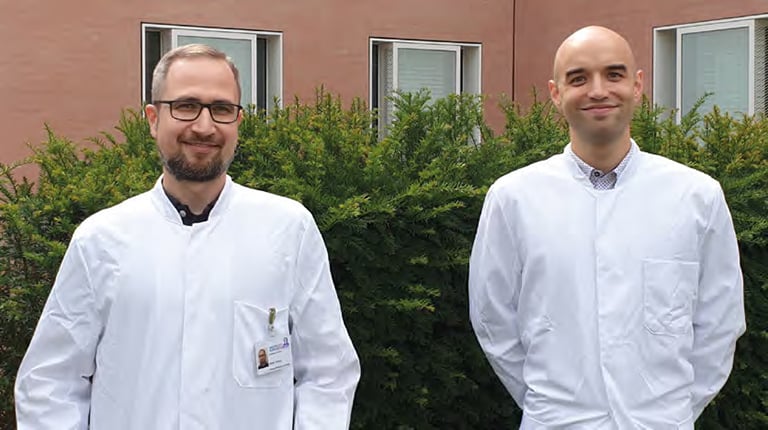Tecan uses cookies to improve our website. By continuing to browse our website, you accept our cookie policy.
Tecan uses cookies to improve our website. By continuing to browse our website, you accept our cookie policy.

Work to characterize and further understand the molecular pathology of SARSCoV- 2 became a focus for many virology departments following the identification of the novel virus responsible for COVID-19. Drs Marek Widera, Alexander Wilhelm and colleagues at University Hospital Frankfurt, Germany, turned their attention to developing an in vitro cell culture model that could realistically mimic the viral replication cycle, to decipher the mechanism of COVID-19 infection.
Prior to the pandemic, the Institute for Medical Virology – part of Goethe University – supported viral diagnostic efforts at University Hospital Frankfurt. However, when the scale of the emerging pandemic became apparent, the team turned its expertise to studying SARS-CoV-2. The group realized that existing methods to monitor and quantify SARS-CoV-2 infectivity in cell culture were both time consuming and labor intensive, so began developing a cell line that could accurately model the way the virus was infecting humans. Marek explained: “We actually stopped all work, except on SARS-CoV-2, and switched completely to look at methods for quantification, and to assess how infectious the virus is. Automatic approaches to cell-based methods were very limited and so, in early 2020, we decided to develop a cell line that was very easy to maintain, had very convenient proliferation characteristics and, most importantly, included a fluorescence cassette as a good starting point for automatic measurements.”
 Marek Widera (left) and Alexander Wilhelm of University Hospital Frankfurt
Marek Widera (left) and Alexander Wilhelm of University Hospital Frankfurt
Using the Sleeping Beauty transposon system, the team generated a robust and versatile cellular infection system based on its A549-AT lung cell line, which allowed high throughput SARS-CoV-2 infection experiments and live cell imaging at a low cost.1 Measuring the cytopathic effect of the virus – structural changes in the host cells caused by viral infection – was a key criterion for the group, which could be assessed by imaging the cells. Marek commented: “Our standard virological assays are performed by assessing cells manually under the microscope, which is time and labor intensive, and requires specially trained personnel. The user needs a lot of experience to assess whether you have a full cytopathic effect or not, and there is room for user variability, especially when they have been evaluating a large number of samples in a session. We decided to transform neutralization tests, IC50 tests, antiviral compound testing and also the determination of the cytopathic effects by combining our newly created A549-AT cell line model with automated measurement and analysis.”
“When the Spark® Cyto was launched, we knew this was exactly the instrument we needed,” Marek continued. “The live cell imaging option and the CO2 control within the measurement chamber were ideal. It was also the perfect size, because the restricted space in our biosafety level 3 (BSL-3) laboratory meant that we could not accommodate large devices.” Alexander added: “Working with the Spark Cyto, we found that, in addition to developing our initial idea of working with immunofluorescence, we were also able to evaluate the cytopathic effect with just the system’s bright field imaging capabilities. That was quite surprising for us, as it was a very new idea, which is why we are now developing this further with great technical support from colleagues at Tecan.”
The live cell imaging option and the CO2 control within the measurement chamber were ideal.
“Several hours after infection, we can observe syncytia formation, where the cell membranes of neighboring cells fuse,” Alexander elaborated. “This is something that you can see clearly with the Spark Cyto system. Depending on the virus strain we are using, we see more or less one giant syncytia formation in the entire well of a 96-well plate. This phenomenon is quite homogeneous with our cell line, and allows for highly standardized readout assays. Optimizing the instrument’s software parameters for A549-AT cells infected with SARS-CoV-2, we developed our own analysis workflow to create standardized protocols for investigators to easily and consistently quantify the cytopathic effect.”
Alexander continued: “The biggest benefit of this approach is speed. For example, if a company or another lab is testing thousands of compounds with our cell line, it would be up to four times faster with the current systems that are available. It’s a combination of the Spark Cyto’s imaging facility and our cell line that enables a low cost and really quick readout method. We are continuously optimizing our current protocols for future high throughput projects, and so we are collaborating with the research and development department at Tecan to build on the success we have already had.”
Marek concluded: “We have already had several requests for the cell line, and now have new collaborators who are using the cells for different purposes. In our lab, we do large cohort studies, because it is still unclear whether immunity or antibodymediated protection continues against new SARS-CoV-2 variants of concern. This assay system will also be easily adaptable to study other viruses with susceptible cell lines in the future. There are many types of virus-induced cytopathic effects, and bright field analysis using the Spark Cyto is a very nice tool to analyze these.”
1) Widera, M et al. Generation of a Sleeping Beauty transposon-based cellular system for rapid and sensitive screening for compounds and cellular factors limiting SARS-CoV-2 replication. Front. Microbiol. doi: 10.3389/ fmicb.2021.701198
To find out more about live cell imaging with Tecan’s Spark Cyto, visit lifesciences.tecan.com/sparkcyto
To learn more about the Medical Virology Team, or to obtain the A549-AT cell model, go to www.kgu.de/einrichtungen/ institute/zentrum-der-hygiene/ medizinische-virologie/team/